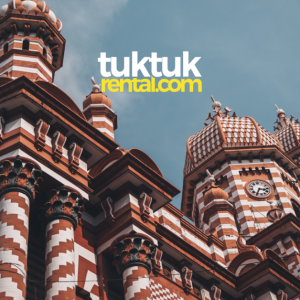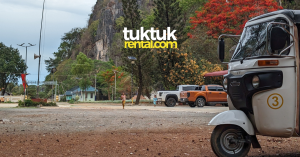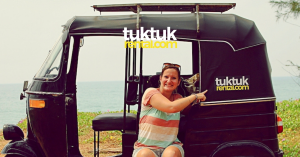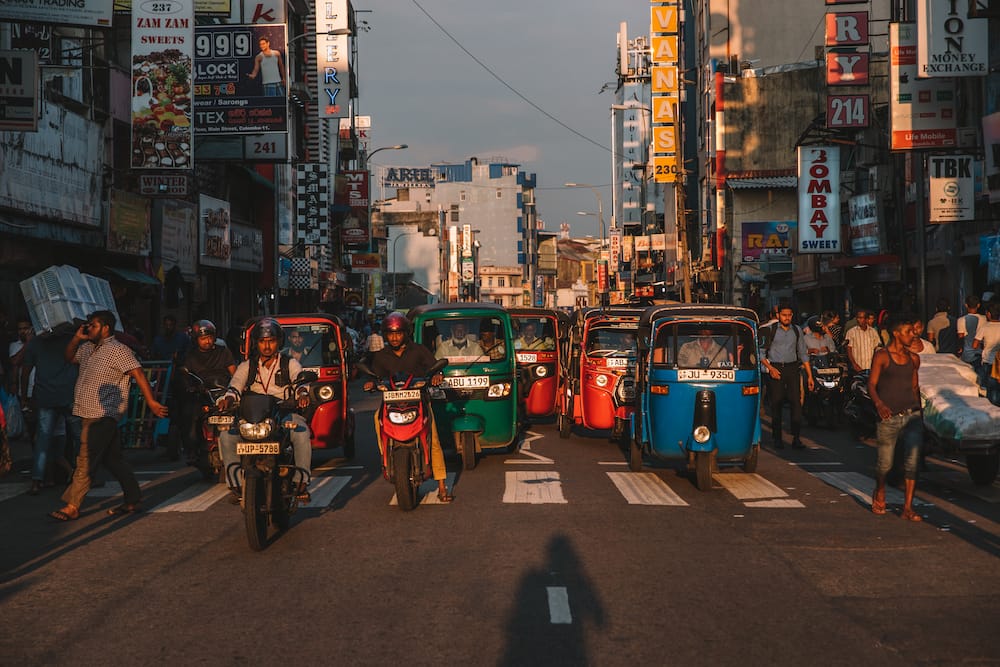
Colombo is often seen as just a gateway to Sri Lanka’s other gems. However, this bustling capital is a destination in its own right. Colombo offers a fascinating mix of old and new. Here, colonial-era buildings stand beside modern skyscrapers. In addition, bustling markets contrast with calm seaside promenades.
Colombo is a dynamic city with a rich heritage. It boasts delicious food, exciting nightlife, and scenic nature escapes. As a result, the city is packed with history, culture, and shopping that make it a fantastic place to visit. It caters to all kinds of travellers, from backpackers to those seeking luxury. Ultimately, Colombo’s blend of colonial charm and coastal beauty makes it a must-visit.
There is no shortage of things to do, from exploring temples to watching sunsets at Galle Face Green. This guide will show you the best of Colombo. Therefore, pack your bags and get ready to explore the heart of Sri Lanka!
Indulge Your Sense at Pettah Market
Pettah Market is one of Colombo’s most vibrant and chaotic places. It offers an authentic slice of local life. This sprawling bazaar is a maze of narrow streets near the Colombo Fort area. Vendors pack the streets, selling everything from fresh produce to souvenirs. In fact, each street specializes in different goods, which makes it exciting to explore on foot.
The market is a wonderful sensory overload. For instance, the smell of exotic spices fills the air while vendors call out their deals. At the same time, tuk-tuks squeeze through crowds of bargain hunters. It is the perfect spot to feel Colombo’s fast-paced energy and find hidden treasures at great prices.
Must visit spots in Pettah:
Pettah Floating Market: A picturesque shopping area on Beira Lake.
Main Street and Cross Street: Perfect for bargain shopping.
Kayman’s Gate Bell Tower: A remnant from the Dutch era.
Local street food: Try isso wade (shrimp fritters) or kottu roti as you shop.
Tip: Pettah can be overwhelming, so wear comfortable shoes and be prepared to navigate crowded streets!
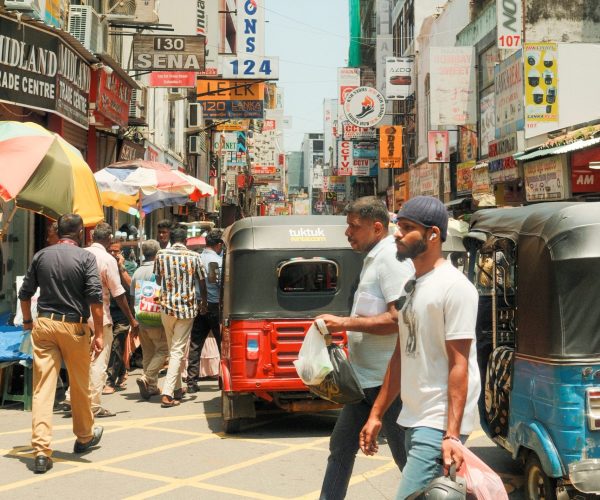
Marvel at the Dutch Era Wolvendaal Church
You can find the Wolvendaal Church in a quiet part of the Pettah district. This 18th-century Dutch Reformed church is one of Sri Lanka’s oldest colonial buildings. The Dutch built it in 1749, and it remains a stunning example of their colonial architecture. In fact, it still functions as a place of worship today.
The name “Wolvendaal” means “Valley of Wolves.” However, people believe jackals, not wolves, once roamed the area. The builders used solid coral and limestone for its construction. Consequently, the structure has stood the test of time. Its sturdy walls, high domed ceiling, and massive teak furniture are all still intact. Furthermore, the carved pulpit and old gravestones in the floor create a timeless, reverent atmosphere.
Pay Respects at the Jami Ul-Alfar (The Red Mosque)
The Jami Ul-Alfar Mosque is one of Colombo’s most iconic landmarks. It is popularly known as the Red Mosque. This striking building is in the heart of the bustling Pettah district. Its vibrant red and white striped exterior makes it truly stand out. Indeed, the design blends Gothic and Indo-Islamic architectural styles.
Creators built the mosque in 1909. They designed it to be visible to ships approaching the harbour, acting as a symbolic welcome. Because of this, its unique minarets, domes, and striped patterns make it a one-of-a-kind building. While non-Muslims cannot enter during prayer times, visitors can usually explore the mosque during quieter hours.
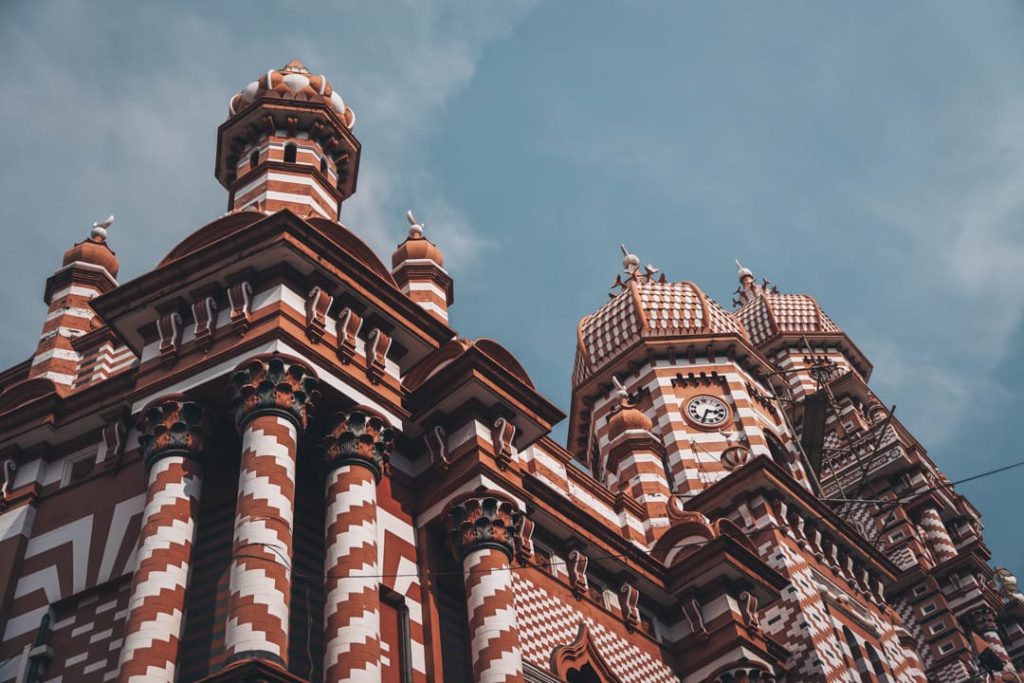
Geek Out On the Architecture at Geoffery Bawa’s House
Number 11, located in Colombo’s Kollupitiya district, was the home of Geoffrey Bawa. He was Sri Lanka’s most famous architect and the pioneer of Tropical Modernism. Bawa acquired the property in 1958. Over several years, he transformed the space by merging four adjacent houses into a single masterpiece. Consequently, the residence showcases his signature style. It seamlessly blends open courtyards and verandas with indoor and outdoor spaces.
Planning Your Architectural Tour
Visitors to Number 11 can explore rooms filled with Bawa’s personal art collection. These unique artifacts reflect his eclectic tastes and design philosophy. For example, the house features a painted door by artist Donald Friend. It also showcases Saarinen tulip armchairs, highlighting Bawa’s global design appreciation.
The residence also offers guided tours for more insight into Bawa’s life. For an immersive experience, the Geoffrey Bawa Trust allows stays in the visitor’s suite. However, it is important to know this is not a regular hotel. The accommodations are specifically for those with a deep interest in architecture and art.
Find Some Peace at Gangaramaya Temple
Gangaramaya Temple is one of Colombo’s most iconic Buddhist temples. Located near the serene Beira Lake, it offers a blend of architectural styles and cultural artifacts. The esteemed scholar monk Hikkaduwe Sri Sumangala Nayaka Thera established the temple in the late 19th century. Since then, it has grown into a large complex. Its architecture uniquely fuses Sri Lankan, Thai, Indian, and Chinese styles. You can see this in the intricate woodwork and elaborate carvings.
Gangaramaya also contains a museum, library, and vocational training centers. The museum holds an eclectic collection of religious artifacts, antiques, and gifts. These items reflect the temple’s rich history. Adjacent to the main temple is Seema Malakaya, a tranquil meditation hall. Renowned architect Geoffrey Bawa designed this serene space, which floats atop Beira Lake. It offers a peaceful retreat from the city’s chaos.
Things to see at Gangaramaya:
A sacred Bodhi tree.
A collection of ancient Buddhist statues.
A vintage car museum with rare vehicles.
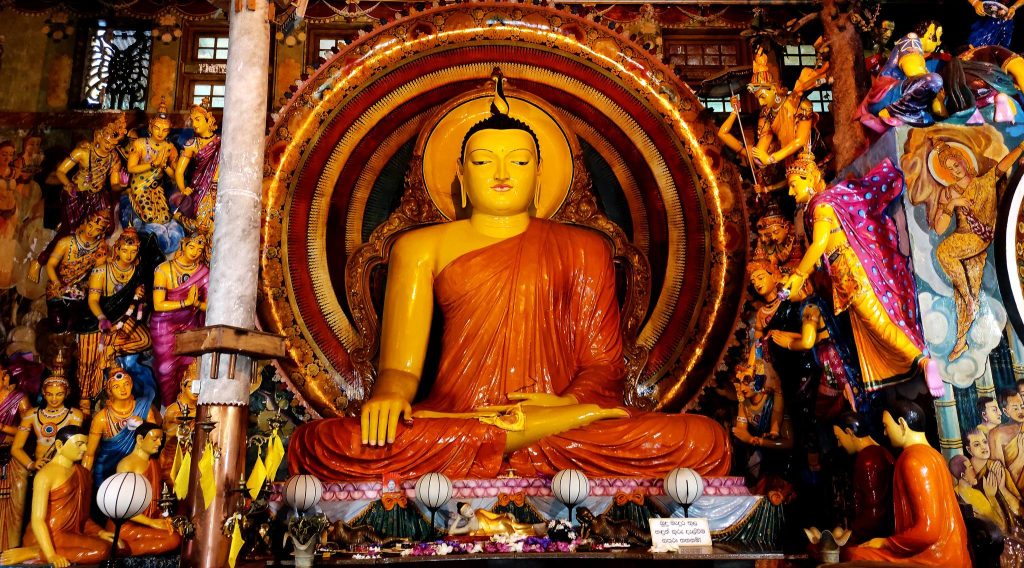
Enjoy the Views from Sambodhi Chaithya
Sambodhi Chaithya is a unique Buddhist stupa within Colombo Harbour. The renowned Sri Lankan engineer A. N. S. Kulasinghe designed it. Its construction began in 1956 to mark the 2,500th anniversary of Buddha’s enlightenment. The stupa’s distinctive design truly sets it apart. It sits on a platform supported by two interlocking concrete arches, rising about 33 meters high. This elevation was intended to make the stupa visible to approaching ships, symbolizing a beacon of peace.
To reach the stupa, you must climb a staircase of 123 steps. The climb offers panoramic views of the harbour and cityscape. The stupa itself is bell-shaped and houses a serene meditation hall underneath. This hall provides a tranquil space for reflection away from the bustling port.
Gor for a Sunset Dip at Mount Lavinia Beach
Colombo may not be famous for its beaches, but nearby spots are a welcome surprise. Mount Lavinia Beach is a beloved destination just south of the city. It is perfect for both locals and tourists seeking a seaside escape.
The beachfront has an array of restaurants and pubs. Here, you can savour fresh seafood while enjoying ocean views. For example, establishments like The Lavinia Breeze and La Voile Blanche offer a great blend of local and international cuisine. A sunset dip or sunbathing session, followed by dinner, is a perfect way to experience the best of this area.
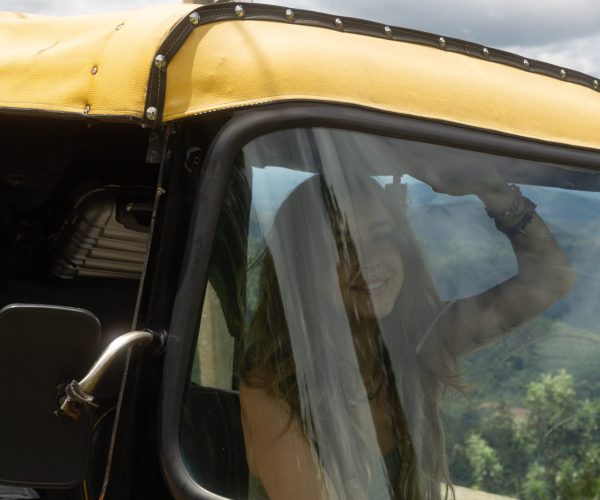
Discover Colombo’s Nightlife
When the sun sets, Colombo’s nightlife kicks into gear. The city offers something for every kind of night owl. You can find lively clubs, laid-back beach bars, and chic rooftop lounges.
Start your evening with sunset cocktails at a stylish rooftop bar. For instance, Botanik and Cloud Red are popular choices with stunning skyline views. For a more casual vibe, head to The Love Bar for great music and an international crowd. If you want to dance, Disques and Rhythm and Blues keep the party going late. Finally, jazz lovers can check out Ask for Fern or Jazzebel Colombo for a more intimate setting.
Some more nightlife recommendations:
- Sky Lounge at T
Sky Lounge at The Kingsbury: A rooftop bar with ocean views.
Bally’s Casino: The largest casino in Sri Lanka.
Shangri-La’s Capital Bar & Grill: Perfect for cocktails and jazz nights.
Go People Watching at Diyatha Uyana Park
Diyatha Uyana Park is a lovely urban oasis in Battaramulla. Transformed from marshy land, this park offers a serene environment for relaxation. You can take leisurely strolls along the pathways or enjoy a boat ride on the calm waters.
The park also features a children’s play area, making it ideal for family time. In addition, there is a food court with a variety of local and international cuisines. The floating restaurant on Diyawanna Lake offers a unique dining experience with scenic views.
Pig Out at the Ministry of Crab
While Colombo’s food scene is vast, Ministry of Crab deserves a special mention. This restaurant is a must-visit. You can find it inside Colombo’s historic Dutch Hospital complex. Ministry of Crab celebrates Sri Lanka’s rich culinary heritage, specifically its world-renowned mud crab. The celebrated chef Dharshan Munidasa founded it in 2011. He partnered with cricket legends Mahela Jayawardene and Kumar Sangakkara. As a result, this restaurant consistently ranks among Asia’s 50 Best Restaurants.
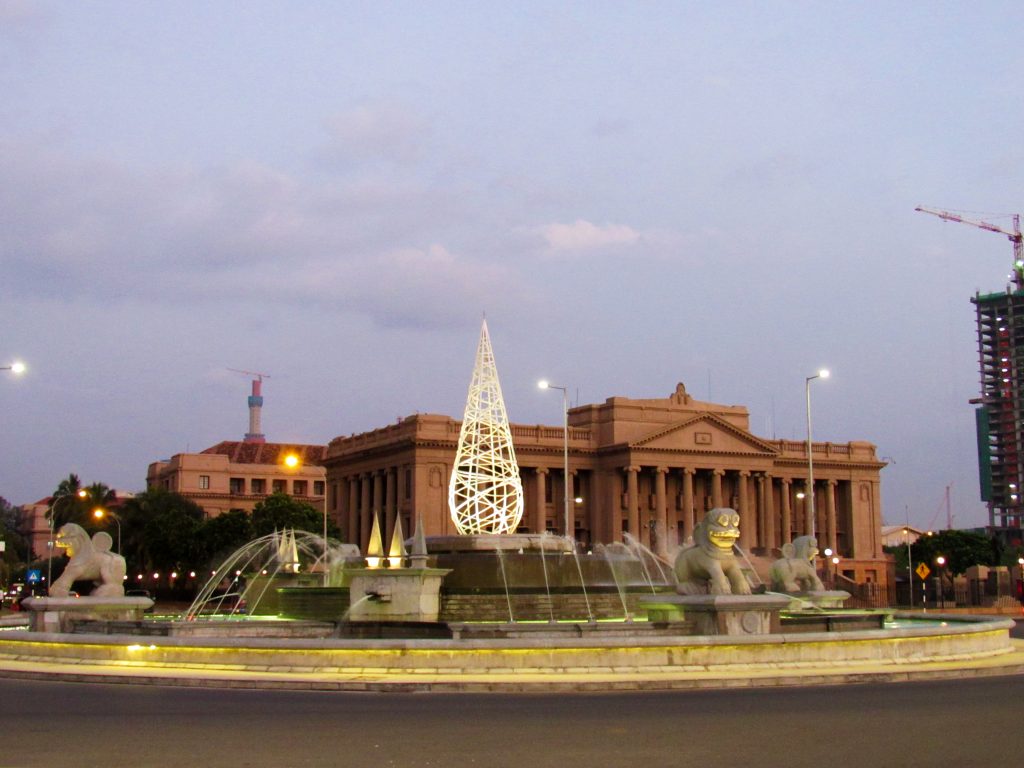
Sample Street Food at Galle Face Green
Galle Face Green is a prominent urban park along the Indian Ocean. Governor Sir Henry George Ward established it in 1859. Initially, the area was cleared to give cannons a clear line of fire. Over time, however, it has become a beloved public space.
The open lawns and seaside promenade are a hub for many activities. For example, families gather for picnics, and children fly colourful kites. As the sun sets, Galle Face Green becomes a culinary hotspot. Street food vendors offer local delicacies like isso wade (spicy prawn fritters) and kottu roti.
Look Over Colombo’s Skyline from Lotus Tower
The Lotus Tower is a prominent feature of Colombo’s skyline, standing at 351.5 meters tall. It is one of the city’s newest landmarks and the tallest self-supported structure in South Asia. The tower’s design takes inspiration from the lotus flower, which symbolizes purity in Sri Lankan culture.
The observation deck on the seventh floor offers panoramic 360-degree views of the city. For a unique dining experience, visit the Blue Orbit revolving restaurant on the 26th floor. It offers diverse international cuisines with ever-changing vistas. Tickets for foreign visitors cost $20 and grant access to the observation deck and an art installation. Visiting at sunset is a great way to see the colours change over Colombo.
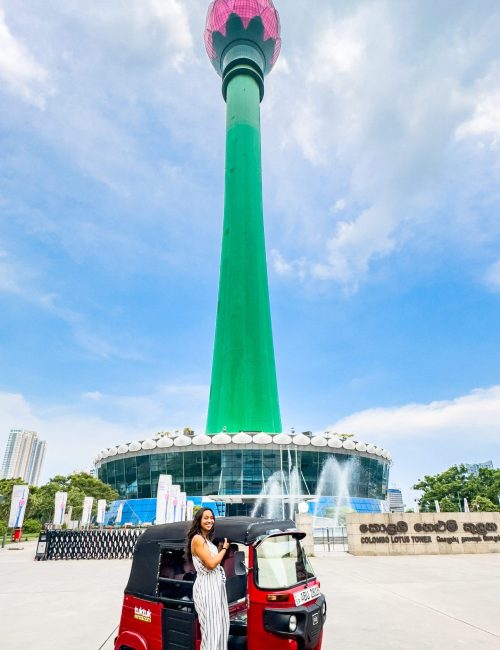
Go Scuba Diving
Colombo’s coast hides a vibrant underwater world perfect for scuba diving. The Indian Ocean’s warm waters offer good visibility from November to April. Moreover, a variety of dive sites cater to both beginners and experienced divers.
The coastline has an abundance of shipwrecks, making it a wreck diver’s haven. Sixteen wrecks, including the historic HMS Hermes, have become thriving coral reefs. These reefs are home to diverse marine life like reef fish, moray eels, and even sharks. Several local dive centers, such as Island Scuba, offer certified courses and guided dives. Consequently, Colombo’s dive scene is surprisingly rich and accessible.
Shop for Souvenirs at Old Dutch Hospital
The Old Dutch Hospital is located in the heart of Colombo Fort. People believe it was established before 1681, making it the oldest building in the area. It originally served as a hospital for the Dutch East India Company. The building’s design reflects 17th-century Dutch colonial style with thick walls and high ceilings.
In 2011, the building was restored and transformed into a shopping precinct. Today, it is a vibrant hub for shopping, dining, and entertainment. You can find upscale boutiques, souvenir shops, and art galleries that showcase local craftsmanship. This makes it a truly unique shopping district.
Enjoy a Heritage Walk Around Colombo Fort
Colombo Fort, the city’s historic quarter, offers a fascinating journey through time. The Portuguese first built a fortified base here in the 16th century. Later, the Dutch and British expanded it. Now, Colombo Fort is a vibrant mix of colonial architecture and modern commerce.
Wandering through Fort’s wide streets, you will discover grand colonial buildings. For instance, you can see the Old Parliament and the Lighthouse Clock Tower. Another must-visit place is Cargills & Millers, a historic department store with a red brick façade. For a deeper dive into history, you can also take a guided walking tour of the area.
Looking for more inspiration for your Colombo itinerary? Here is our guide to 50 places to visit in Colombo!
You might also consider downloading the Tuktukrental Travel App. It features offline maps, offbeat recommendations and even helps fellow tuktuk-ers on the road connect for information or a few post-drive beers – or the local Sri Lankan arrack if you are feeling adventurous!

